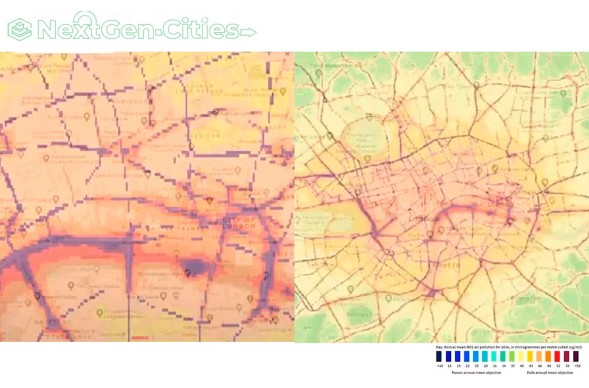Every year, 7 million deaths are due to air pollution exposure. Undoubtedly a devastating fact, which, much to our regret, often goes unnoticed. But that is not all: 91% of the world’s population lives in places where air pollution exceeds safe limits. A fact that is completely related to the increase in mortality due to Covid-19: Long-term exposure to air pollution is associated with an 11% increase in deaths from this disease.
These are some of the spine-chilling data
Marc Ottolini, Airlabs’ CEO, exposed during his presentation in the
Global Next Gen event, organized by Zigurat.
On the basis of this problem, Airlabs’ mission, in Ottolini’s words, is to
make the air pollution problem visible and to
provide solutions for mitigating it. In this line, they develop air quality solutions for cities, mobility and buildings.
“What gets measured, gets done”, sentences Ottolini, who assures that there is an urgent need for action that starts with an
awareness phase, only possible with
measurement of air conditions.
Air pollution is hyper-local, and even major cities monitoring is insufficient
What is, for example,
Barcelona doing, in terms of
air quality monitoring? The city has at the moment
11 air quality monitoring stations, explains Marc Ottolini. 11 quality monitoring stations for a city of over a hundred square km. That means Barcelona has
one sensor per 10 square kilometers.
And this fact is related to another problem:
air pollution is hyper-local, and its
fluctuations over distance and time are
very significant:
“If you measure things on one street, two or three blocks further away the situation can be very different” points out the Airlabs’ CEO.

Marc Ottolini's Presentation at Global Next Gen
These
monitoring stations have major
drawbacks: they take a
lot of space, are
very expensive (also their maintenance) and
provide data at a single point in space (cannot capture the hyper-local variations).

Air Quality Monitoring Station. Source: Airlabs
It is clear that there is a problem in current Air Quality Monitoring management, but,
is there any alternative?
Low-cost IoT sensors for creating Air Quality Monitoring Networks
“Low-cost IoT air quality sensors are small, can be mounted, for example, in lamp posts and give data really where you are”, assures Marc Ottolini.
With these sensors, therefore, it could be possible to
create networks that offered a
more accurate view of the air pollution situation in a region.
Also, he points out some
challenges these solutions face: Data accuracy, the need for calibration, and the inexistence of a formal standard. It is important, Marc assures, that sensors can give guaranteed data whilst it does not require a significant calibration need.

Different types of IoT sensors. Source: Airlabs
Regulation for IoT sensors is necessary, and Europe is taking the initiative
“Local authorities are wary about investing in this kind of devices because they do not know what to specify and how to determine if a product is fit for purpose”, explains Marc Ottolini.
However, he adds that they expect that a
European standard will be in place next near, which will be the first standard in the world:
“I expect that it will unlock the market because people will finally have a yardstick against which to determine which products are fit for purpose”, assures Ottolini.
Air Quality Monitoring: a tool to achieve an objective
Having Air Quality Monitoring systems is the first step to improve air quality, but the
value is in the use cases: How can this data be used in such a way that really brings improvement?
There is a range of possibilities: to
resolve local pollution hot spots, create
intelligent Low Emission Zones,
Influence Citizen behavior and inform citizen action or
feed Machine Learning algorithms for robust analysis and prediction are some of them.
Authorities and Citizens approaches are both needed to mitigate air pollution
Regulatory Solutions can allow authorities to better manage their city operations, whilst citizens also should play an active role in the mitigation of air pollution. Successful implementations, therefore, should have seamless integration with high-level information platform used by Local Authorities and also be integrated with data sharing platforms used by citizens.
Because air pollution, highlights Ottolini, is a
society’s responsibility:
“Air pollution is not something that is being done to us by some abstract entity. It is something we are doing to ourselves. (…) We all make very small contributions to the problem, and therefore none of us feel really responsible, but the combined effect of all of us is the bad air pollutions problems that we have around the world”.


 Marc Ottolini's Presentation at Global Next Gen
These monitoring stations have major drawbacks: they take a lot of space, are very expensive (also their maintenance) and provide data at a single point in space (cannot capture the hyper-local variations).
Marc Ottolini's Presentation at Global Next Gen
These monitoring stations have major drawbacks: they take a lot of space, are very expensive (also their maintenance) and provide data at a single point in space (cannot capture the hyper-local variations).
 Air Quality Monitoring Station. Source: Airlabs
It is clear that there is a problem in current Air Quality Monitoring management, but, is there any alternative?
Air Quality Monitoring Station. Source: Airlabs
It is clear that there is a problem in current Air Quality Monitoring management, but, is there any alternative?
 Different types of IoT sensors. Source: Airlabs
Different types of IoT sensors. Source: Airlabs
